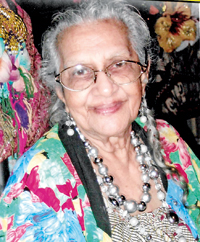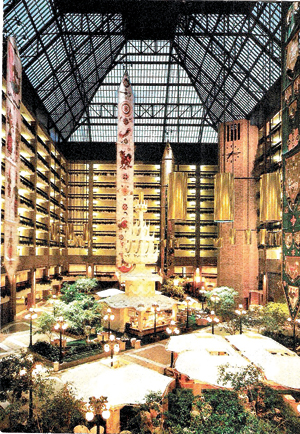Giant batiks that turned heads, skywards

The way it once looked: The atrium of the Lanka Oberoi dominated by Ena’s giant batiks and below, the individual pieces
On March 3, 2005, largely unnoticed by the public, a drama unfolded in the busy lobby and central atrium of the Cinnamon Grand Hotel, then known as the Hotel Lanka Oberoi. Three gigantic batik hangings or banners, which had been suspended from the hotel’s ceiling were taken down. The largest measuring 62 feet in length and 15 feet in width, had been the central focus of the atrium for almost three decades, dazzling visitors to the hotel.
Two newspapers of the day, The Sunday Island and The Observer reported conflicting dates of the taking down of the banners, the former stating it took place on February 27, 2005 and the latter on March 3, 2005, almost four days later!
Batik hangings of this magnitude and size are unique—no textile-based artwork of this scale is known from anywhere else in the world. They were the brainchild of the visionary Sri Lankan designer, Ena de Silva, a self-taught artist and craftsperson of great skill.
The saga of the hotel began way back in 1966 when the Sri Lankan Government and the Tourist Board decided that for a successful tourist industry a prerequisite was a contemporary hotel with modern conveniences. After eventual approval from Parliament, a site owned by the Anglican Church in Kollupitiya in the heart of Colombo, was identified. The next step was to employ an architectural firm to advise the State and prepare the designs and supervise the construction work of the proposed hotel. A prestigious U.S firm – Skidmore Owings and Merrill (SOM),was selected to design the new hotel. Established in 1936 in New York City, the firm now has regional offices in San Francisco, Los Angeles, Washington, D.C., London, Hong Kong, Shanghai, Dubai and Mumbai.
SOM’s unique design for the Oberoi Hotel in Colombo was based on the concept of a central atrium and courtyard, measuring 120 feet by 120 feet and 8 storeys (approximately 120 feet) high with skylights illuminating the whole atrium. The SOM design had architectural features similar to that of the work of architect Kevin Roche who built the Headquarters of the Ford Foundation in New York City.Visiting this building in 1968 I was intrigued to find huge trees and a variety of foliage in the central atrium. During winter while New York was freezing and the pavements were covered in snow, the atrium was a warm oasis. In contrast, in summer, when temperatures rose to nearly 30 degrees Celsius, the atrium was cool with air conditioners softly humming away.
Meanwhile by 1967 the government had initiated a study on the various local arts and crafts that could provide the incentive for the tourist industry and particularly hotels. The Chairman of the Tourist Board Cecil de Soysa, employed Dale and Patricia Keller as interior consultants and by May 1967 published “A Report on the Handicrafts of Ceylon’ which highlighted the steps required to develop the nascent handicraft industry.

Ena de Silva
It was the outcome of their observations of the 40 arts and crafts studios and workshops across the island visited by the duo that eventually led to the choice of Ena de Silva to collaborate with SOM architects in designing the banners.
The design and batik process of the huge hangings
The process of creating batik in five or more colours on such a large scale is notoriously difficult. Both sides of the cloth on which the design is set have to be carefully waxed so that the individual parts of the design that are to be dyed in different colours do not overlap or run into each other. After each round of dyeing, the cloth is boiled in hot water and the wax completely removed before the cloth is re-waxed to receive the next colour. The writer having worked on 18-feet-long batiks at Ena’s workshop knows how problematic and time consuming it is to create large-scale batik hangings. The batiks for the Oberoi Hotel were particularly gigantic.
One of the drawbacks was that the dye vats used at Ena’s workshop in Kotte were no more than 12 to 14 feet in length. Although the pieces were dyed separately, each piece when it was soaked during the dyeing process became immensely heavy and difficult to handle. Moreover to protect the textile from being damaged during handling, transport and hanging, the cloth had to be reinforced along the edges.The team of craftspersons (largely women) who worked on these banners were hand-picked and trained by Ena. The designs and motifs used in the batiks were traced from sketches executed by Anil Gamini Jayasuriya, Ena’s son who was an exceptionally talented artist. In 1974, Anil was recovering from the effects of a nasty traffic accident.
 To hoist the banners, an 80-foot-high scaffold was set in place. A Hong Kong based lighting consultant was recruited to ensure that the hangings were dramatically lit to display the vibrant colours and design. By September 1975 the batiks were already in position at the Hotel’s atrium for the official opening of the Hotel Lanka Oberoi.
To hoist the banners, an 80-foot-high scaffold was set in place. A Hong Kong based lighting consultant was recruited to ensure that the hangings were dramatically lit to display the vibrant colours and design. By September 1975 the batiks were already in position at the Hotel’s atrium for the official opening of the Hotel Lanka Oberoi.
In September 1976 the Non -Aligned Conference was hosted by Sri Lanka and attended by as many as 60 heads of state, including Indira Gandhi, Fidel Castro, Marshal Tito, Archbishop Makarios, Kenneth Kaunda and more. Several Heads of State stayed at the Oberoi Hotel and appreciated the effort of producing such a work of textile art – Indira Gandhi took a personal interest in Ena de Silva’s work.
Design of the berunda pakshaya and other astrological symbols
The outcome of the design was several years of research and study by Ena of the traditional design motifs of the flags and banners of the various districts (Korales) throughout the Kandyan Kingdom. Over the years she experimented with the designs and motifs and the outcome was several similar designs, which were commissioned and displayed at the Ceylon Pavilion at the Expo in Montreal 1970, the Headquarters of the Institute of Accountants, London and Sussex University. She drew her inspiration largely from the Museum publication ‘The Flags and Banners of Ceylon’(1916) by Edward. W. Perera.
The most dominant motif was the one that depicts the Berunda Pakshaya, which E. W. Perera has stated, regularly occurs in the flag of the Korale Tuna Disawa at Kegalla.
The Berunda Pakshaya motif has its origin in South India and is common in the Karnataka region where some of the earliest examples of this design were cast on the coins in circulation during the first reigns of the Kings of the Vijayanagar Dynasty around 1505.
The usual motif, which is often repeated, is that of the bird of prey, usually a double eagle. The image has been cast, engraved, carved or printed on a range of materials such as metal, stone, timber, paper and textile. It is now the official state insignia of the government and of Karnataka
In Sri Lanka too it is widely deployed and one of the best examples of such a design is the double-headed bird on one of the timber columns that supports the roof structure at the 14th century Embekke Devale close to Gampola.
Ena’s unique Oberoi hotel banners that were taken down were handed to this writer, who was requested to restore and care for them until a decision was taken about their fate. They are now safely stored at architect Amila de Mel’s studio and residence at Mirihana.
(Author’s note: Ranil Bible in Vancouver, Canada was largely responsible in getting some of the vital data, including the rare picture postcard of the Lowes Hotel Dallas, Texas (see far left). But he is in no way responsible for any errors of dates and names mentioned in the body of my article)
| All the way to Texas | |
 In late 1974 or early 1975, a Texas tycoon visiting the Oberoi Hotel was impressed by these hangings and commissioned Ena de Silva to execute banners of a similar size for the interior of the Lowes Anatole Hotel on Stemmons Freeway, in Dallas where they were displayed in a similar manner to that of the Oberoi Hotel. In late 1974 or early 1975, a Texas tycoon visiting the Oberoi Hotel was impressed by these hangings and commissioned Ena de Silva to execute banners of a similar size for the interior of the Lowes Anatole Hotel on Stemmons Freeway, in Dallas where they were displayed in a similar manner to that of the Oberoi Hotel. Intriguingly, the layout of the hotel in Dallas, Texas in many ways, was identical in design to the Oberoi and most likely, SOM had some influence on its architecture. Unfortunately in 2000 or after the upgrading of the hotel interior, the banners were taken down meeting the same fate as the Oberoi Hotel banners.
|


